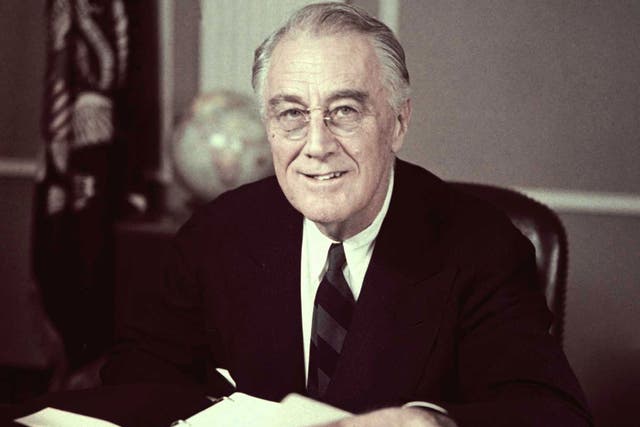
Before the 22nd Amendment, presidents could run for more than two terms—but only FDR managed to win more than two consecutive elections.
Updated: October 22, 2019 | Original: October 16, 2019

On November 5, 1940 Franklin D. Roosevelt broke a long-held precedent—one that started with George Washington—when he became the first president elected to a third term. Roosevelt would go on to vie for, and win, yet a fourth term, taking office again on January 20, 1945.
FDR was the first, and last, president to win more than two consecutive presidential elections and his exclusive four terms were in part a consequence of timing. His election for a third term took place as the United States remained in the throes of the Great Depression and World War II had just begun. While multiple presidents had sought third terms before, the instability of the times allowed FDR to make a strong case for stability.
“You have economic-domestic issues and you have foreign policy with the outbreak of World War II in 1939,” says Barbara Perry, professor and director of presidential studies at the University of Virginia’s Miller Center. “And then you have his own political viability—he had won the 1936 election with more than two-thirds of the popular vote.”
America 101: Why Do We Have Presidential Term Limits?Eventually U.S. lawmakers pushed back, arguing that term limits were necessary to keep abuse of power in check. Two years after FDR’s death, Congress passed the 22nd Amendment, limiting presidents to two terms. Then amendment was then ratified in 1951.
At the time of FDR’s third presidential run, however, “There was nothing but precedent standing in his way,” says Perry. “But, still, precedent, especially as it relates to the presidency, can be pretty powerful.”
According to the National Constitution Center, most of the framers of the Constitution were against term limits, and, although amendments seeking to enforce them were proposed some 200 times between 1796 and 1940 without being adopted, most two-term presidents followed Washington’s precedent in not seeking reelection for a third time.
Still, some had tried. Ulysses S. Grant lost a third campaign in 1880, when James Garfield clinched the Republican nomination. Theodore Roosevelt lost his bid at a third nonconsecutive term in 1912 to William Howard Taft (he had previously served out the remainder of President William McKinley's term and then won reelection). And Woodrow Wilson lost the Democratic nomination in 1920. Harry Truman, who succeeded FDR after his death, was president when the 22nd Amendment passed and so was exempt from the new rule. Truman campaigned for a third term in 1952, but withdrew after losing in the New Hampshire primary.
Franklin D. Roosevelt's vice president was an anti‑labor conservative who clashed with the president over federal spending and FDR's decision to run for a third term.
When he sought a fourth term at age 62, FDR's doctor had issued a dire prognosis.
Security fears and austerity forced a scaled‑down inauguration as the nation entered its fourth year of fighting in World War II.
Roosevelt’s campaign for a third term took place as the United States had not yet entered World War II, and the president was still trying to hold the line in an isolationist pattern.
“He was trying to guide us along to try to keep Britain afloat with things like lend-lease,” Perry says. “That obviously was preying on his mind and he didn’t think that the U.S. should ‘change horses in midstream’ as this war was building towards what he knew would eventually be our full-fledged intervention in both the European and Pacific theaters.”
Roosevelt’s defeat of Republican challenger Governor Alf Landon of Kansas was a rout—the fourth-largest electoral vote margin ever. His 1940 win against Republican businessman Wendell Willkie wasn’t quite as impressive, but he still won 55 percent of the popular vote, and took the electoral vote 449 to 82.
Of course, not everyone was on Roosevelt’s side. The National Constitution Center notes that his decision to run for a third term resulted in key Democratic supporters and advisors leaving his campaign.
Some political buttons from the time read “FDR Out at Third,” and Perry notes that despite his popularity, one-third of Americans, particularly business people and those with means, still voted against him. They argued he was taking America down the road of socialism.
“Famously, there were people who would refuse to speak of him by name and would call him ‘That Man,’” Perry says. “But he knew the popular vote and the electoral vote were on his side. He wanted to see us through the two greatest catastrophes of the 20th century and he succeeded.”
In 1944, according to the National Constitution Center, term-limit talk again came into focus. Republicans were at the forefront of the movement, though many Democrats agreed with the eight-year precedent set by Washington to guard against tyrannical rule.
“Four terms or 16 years is the most dangerous threat to our freedom ever proposed,” Thomas Dewey, Roosevelt’s Republican opponent, said in a 1944 speech.
Roosevelt won his fourth term when he defeated Dewey with 54 percent of the popular vote, taking the Electoral College 432 to 99. He died April 12, 1945, 11 weeks into his term, and the call for a constitutional term-limit amendment was answered two years later, with a two-thirds majority voting in favor of the 22nd Amendment.
The amendment reads: “No person shall be elected to the office of the President more than twice, and no person who has held the office of President, or acted as President, for more than two years of a term to which some other person was elected President shall be elected to the office of the President more than once.”
Stream U.S. Presidents documentaries and your favorite HISTORY series, commercial-free